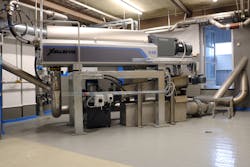During the treatment of municipal wastewater, a large amount of sewage sludge is produced at the end of the process chain. In order to transport, recycle, dispose or incinerate the dewatered sludge, it is essential that the sludge has a high dry solids content.
Other important factors are the economical use of polymers, water, and energy, as well as reduced wear. Looking at the overall balance, about 75 percent of the costs are attributable to the disposal of the sewage sludge,15 percent to polymer consumption and the rest to energy and other ancillary costs. It can be concluded from this that efficient sludge treatment leads to savings in all of these three cost blocks.
For this reason, two operators of sewage treatment plants in Finland have decided to reorganize their mechanical treatment processes. Both the Turku Region purifier and the Seinäjoki sewage treatment plant were able to realize savings on their operational costs after employing new decanter centrifuges from Flottweg.
Fast Returns at the Turku Sewage Treatment Plant
Turku — located where the river Aurajoki flows into the Baltic Sea — is the sixth largest city in Finland, with almost 200,000 inhabitants. The city is an important research location in Finland with various universities, academies and research companies. The city’s only sewage treatment plant, the Turku Region Purifier, is similarly innovative.
The plant processes the region’s industrial wastewater and that of almost 300,000 inhabitants in the region of Turku. Built completely beneath the city several years ago, seen from inside, the wastewater treatment plant has the appearance of a small town.
Until a few years ago, the entire sewage sludge dewatering process was performed with two older decanter centrifuges. Based on the centrifuges’ weak separation results, the plant’s operators decided to take a proactive approach to the treatment of their wastewater for the area’s future needs.
After detailed examination and consideration of several key factors, the decision was made to purchase two decanter centrifuges from Flottweg for use at the plant.
“In these [two] years [of service], we have saved sludge costs of €150,000 ($174,000 USD) per year because the dry matter content has increased by about five percent,” Tuomi said. “At the same time, we have saved polymer costs of about €15,000 ($17,400 USD) per year and energy costs of about €3,000 ($3,480 USD) per year.”
As a result of the savings, the operators of the plant have succeeded in recouping a machine‘s purchase costs within just one year.
Massive Savings in Seinäjoki
The Seinäjoki Central Sewage Treatment Plant is designed to treat the needs of the equivalent of 100,000 inhabitants and nearby industries. Located in South Ostrobothnia, Finland, 80 km (50 miles) east of Vaasa, the facility currently operates at around 90 percent capacity.
Seinäjoen Vesi Oy is responsible for the design, construction, and maintenance of the city’s water and sewerage network. The sewage treatment plant has used centrifuges for its sludge treatment for 20 years, but recent developments in the quality of the wastewater being received at the plant required an update to the dewatering technology being used.
“After detailed discussions with my colleagues from all over Finland, we decided on a decanter centrifuge from Flottweg,“ Juha Korpi, manager of the Seinäjoki sewage treatment plant said. “Good results were obtained in nationwide tests, so the decision was not difficult.”
After only a few months of operation, the sewage treatment plant reduced its sludge treatment costs by around 25 percent.
“We are very happy with the Flottweg machine,“ Korpi said.“The commissioning went very smoothly, and the delivery took place on schedule. The machine’s high performance enables us to amortize the investment within approximately two years.”
The most important goal in dewatering is to maximize the reduction of the volume of sewage sludge. Massive savings potential for sewage treatment plants worldwide can be discovered here. WW
About the Author: Nils Engelke is a public relations and communications manager for Flottweg.
Published in WaterWorld magazine, November 2021.






